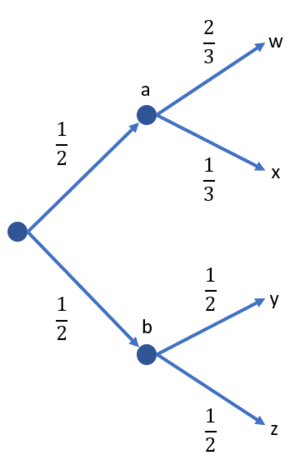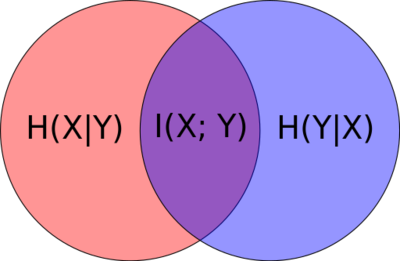Joint Entropies
In this module, we'll discuss several extensions of entropy. Let's begin with joint entropy. Suppose we have a random variable  with elements
with elements  and random variable
and random variable  with elements
with elements  . We define the joint entropy of
. We define the joint entropy of  as:
as:
-
 |
|
(1)
|
Take note that  . This is trivial. From our previous discussion about the decision trees of a game, we used joint entropies to calculate the overall entropy.
. This is trivial. From our previous discussion about the decision trees of a game, we used joint entropies to calculate the overall entropy.
Conditional Entropies
There are two steps to understand conditional entropies. The first is the uncertainty of a random variable caused by a single outcome only. Suppose we have the same random variables  and
and  defined earlier in joint entropies. Let's denote
defined earlier in joint entropies. Let's denote  as the conditional probability of
as the conditional probability of  when event
when event  happened. We define the entropy
happened. We define the entropy  as the entropy of the random variable
as the entropy of the random variable  given a
given a  happened. Take note that we're only interested in the entropy of
happened. Take note that we're only interested in the entropy of  when only the outcome
when only the outcome  occurred. Mathematically this is:
occurred. Mathematically this is:
-
 |
|
(2)
|
Just to repeat because it may be confusing, equation 2 just pertains to the uncertainty when only a single event happened. We can extend this to the total entropy  when any of the outcomes in
when any of the outcomes in  happens. If we treat
happens. If we treat  contains a range of
contains a range of  and the probability distribution for each associated
and the probability distribution for each associated  is
is  so that
so that  is a function of
is a function of  . Then we define
. Then we define  as the conditional probability of
as the conditional probability of  given
given  as:
as:
-
 |
|
(3)
|
Substituting equation 2 to equation 3 and knowing that  . We can re-write this as:
. We can re-write this as:
-
 |
|
(3)
|
Note that it is trivial to prove that  if
if  and
and  are independent. We'll leave it up to you to prove this. A few hints include:
are independent. We'll leave it up to you to prove this. A few hints include:  and
and  if
if  and
and  are independent.
are independent.
Binary Tree Example

Figure 1: Binary tree example.
Let's apply the first two concepts in a simple binary tree example. Suppose we let  be a random variable with outcomes
be a random variable with outcomes  and probabilities
and probabilities  . Let
. Let  be the random variable with outcomes
be the random variable with outcomes  . We are also given the probabilities
. We are also given the probabilities  ,
,  ,
,  , and
, and  . Figure 1 shows the binary tree. Calculate:
. Figure 1 shows the binary tree. Calculate:
(a) 
(b) 
(c) 
(d) 
Solution
(a) Use equation 2 to solve 

(b) Same as in (a), use equation 2 to solve 

(c) Can be solved in two ways. First is to use equation 3.

Or, we can solve it using the alternative version of equation 3. But we also need to know the joint probabilities:





(d) We already listed the joint probabilities in (c). We simply use equation 1 for this:

Important Note!
This example actually shows us an important observation:
-
 |
|
(4)
|
We can easily observe that this holds true for the binary tree example. This has an important interpretation: The combined uncertainty in  and
and  (i.e.,
(i.e.,  ) is the sum of that uncertainty which is totally due to
) is the sum of that uncertainty which is totally due to  (i.e.,
(i.e.,  ), and that which is still due to
), and that which is still due to  once
once  has been accounted for (i.e.,
has been accounted for (i.e.,  ).
).
Since  it also follows that:
it also follows that:
-
 |
|
(5)
|
If  and
and  are independent the:
are independent the:
-
 |
|
(6)
|
An alternative interpretation to  is the information content of
is the information content of  which is NOT contained in
which is NOT contained in  .
.
Mutual Information
With the final discussion on the properties of joint and conditional entropies, we also define mutual information as the information content of  contained within
contained within  written as:
written as:
-
 |
|
(6)
|
Or:
-
 |
|
(6)
|
If we plug in the definitions of entropy and conditional entropy, mutual information in expanded form is:
-
 |
|
(7)
|
It also follows that:
 . This is trivial from equation 7.
. This is trivial from equation 7.- If
 and
and  are independent, then
are independent, then  . This is also trivial from equation 7.
. This is also trivial from equation 7.
As a short example, we can use the binary tree problem again. Let's compute  . We simply need to use equation 6:
. We simply need to use equation 6:  . We already know
. We already know  bits.
bits.  is computed by first knowing
is computed by first knowing  . Recall that:
. Recall that:

But then, for each outcome in  has the same probability of the joint entropy. For example, event
has the same probability of the joint entropy. For example, event  only occurs if event
only occurs if event  occurred first. Event
occurred first. Event  occurs only if event
occurs only if event  occurred first. So it means that:
occurred first. So it means that:




Therefore,  bits. Therefore, the information
bits. Therefore, the information  bits.
bits.
Graphical Interpretation

Venn diagram visualizing joint entropy, conditional entropy, and entropy.

































































